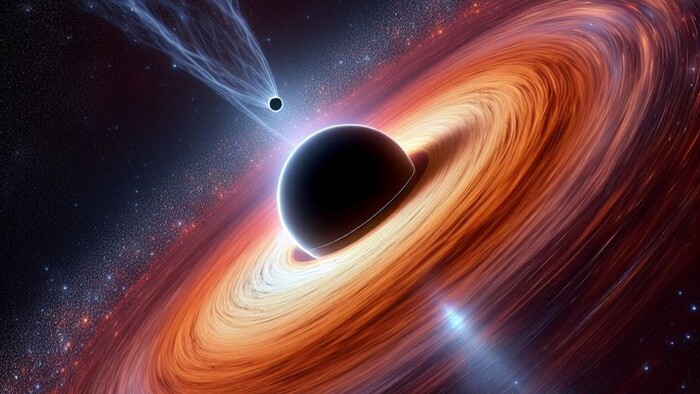Apparently a black hole was ejected from its galaxy.
Now it's hurtling through space, trailing a trail of new stars in its wake.
New Haven - At the center of large galaxies are supermassive black holes that feed on anything that gets close: gas, dust, and stars, for example.
As a rule, the supermassive black holes - one of them is also in the center of the Milky Way - remain in place.
But in rare cases, a black hole can be ejected from its galaxy.
A new study, previously only published on the arXiv
preprint server
but already
accepted by the
Astrophysical Journal Letters , now reports on a supermassive black hole.
It was ejected from its galaxy and is now racing through space.
According to the international research group, the huge black hole generates shock waves on its way and triggers the formation of stars.
Supermassive hole was ejected from its galaxy
The research group led by Yale University astronomy and physics professor Pieter van Dokkum assumes that the black hole was ejected from its galaxy when it merged with another galaxy.
In this process, two supermassive black holes meet, which can coexist peacefully for a very long time.
At the latest, however, when a third galaxy with another supermassive black hole is added, one of the black holes can be "kicked" out of the galaxy.
Although supermassive black holes are huge, they are difficult to find because they absorb all the light and nothing escapes.
However, researchers have now discovered a strange structure in new images from the Hubble space telescope: a narrow, straight strip of newly formed stars that is far from a galaxy.
Black hole leaves star trail behind it
The research group's assumption: On its way through space, the black hole interacts with the circumgalactic medium (the gas that surrounds galaxies).
When the black hole moves through ionized hydrogen, a gas shock wave with a long trail can be created.
In this trail, gas clouds can cool and form stars that look like "knots" in the trail.
"We saw a thin streak in a 'Hubble' image that points directly to the center of a galaxy," van Dokkum told Live Science.
"Using the Keck telescope, we found that the line and the galaxy are connected." The shape of the galaxy suggests that it has merged with another galaxy.
Look into the depths of the universe - This is how "Hubble" sees the universe
Look into the depths of the universe - This is how "Hubble" sees the universe
The stripe in space is more than 200,000 light-years long.
Analysis by the research group shows that the stars in the strip are young - meaning the black hole did not "take" them from its former galaxy.
They must have originated in the gas trail stirred up by the black hole.
Supermassive hole has the mass of 20 million suns
The research team estimates that the black hole, which has the mass of 20 million suns, was ejected from its host galaxy 39 million years ago.
It is now racing through the universe at 5.6 million kilometers per hour.
Even if the research team's observations and calculations clearly speak for a supermassive black hole: There is only one way to determine whether the theory is correct, the authors write: "The 'conclusive proof' for this scenario would be the clear identification of the black holes themselves".
If the research group's theory is confirmed, "it would be the first time that we have clear evidence that supermassive black holes can escape their galaxies," emphasizes Dokkum.
(tab)






/cloudfront-eu-central-1.images.arcpublishing.com/prisa/DGKSYYSAUBHLZJJTPYM7TMTCWM.jpg)

